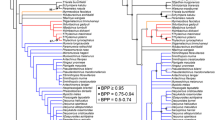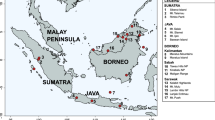Abstract
Sminthopsis is the most speciose genus of living dasyurid marsupials and, along with its close relatives Antechinomys and Ningaui, constitutes the clade Sminthopsini. Phylogenetic relationships among the 23 species in this clade have been the subject of much morphological and molecular investigation, including a recent integration of penis morphology (in Sminthopsis) with molecular systematics. Several phylogenetic issues remain open, however, including the monophyly of Sminthopsis and branching order among early sminthopsin lineages. In this study, we revisit sminthopsin systematics with an expanded molecular data set, including new DNA sequences from mitochondrial (valine transfer-RNA and 16S ribosomal RNA) and nuclear (interphotoreceptor retinoid binding protein and beta-fibrinogen) loci, along with previously published sequences of cytochrome b, 12S ribosomal RNA, control region, and protamine P1. Our results again fail to establish the monophyly of Sminthopsis, but do provide a clearer resolution of early sminthopsin branching. Specifically, our phylogeny suggests three major groups of Sminthopsis species: S. longicaudata (perhaps the sister of Antechinomys); the Macroura species group of previous authors (S. crassicaudata, S. macroura, S. virginiae, S. douglasi, and S. bindi); and the remaining 13 species allied with the Murina species group. Our results depart from previous molecular findings by reuniting S. ooldea with the Murina group, while resolving S. psammophila as sister to the hairy-footed dunnarts (S. hirtipes and S. youngsoni). We suggest that this conflict traces to anomalous phylogenetic signal in previously published cytochrome b sequences. Penis morphology maps reasonably well onto our phylogeny, requiring parallel origination of only one of the ten morphotypes described for Sminthopsis.






Similar content being viewed by others
References
Archer M (1981) Revision of the dasyurid marsupial genus Sminthopsis Thomas. Bull Am Mus Nat Hist 168: 61—224
Baverstock PR, Adams M, Archer M (1984) Electrophoretic resolution of species boundaries in the Sminthopsis murina complex (Dasyuridae). Aust J Zool 32: 823—832
Baverstock PR, Archer M, Adams M, Richardson BJ (1982) Genetic relationships among 32 species of Australian dasyurid marsupials. In: Archer M (ed.) Carnivorous Marsupials. Roy Zool Soc NSW, Mossman, New South Wales, Australia. pp. 641—650
Baverstock PR, Krieg M, Birrell J (1990) Evolutionary relationships among Australian marsupials as assessed by albumin immunology. Aust J Zool 37: 273—287
Blacket MJ, Krajewski C, Labrinidis A, Cambron B, Cooper S, Westerman M (1999) Systematic relationships within the dasyurid marsupial tribe Sminthopsini−a multigene approach. Molec Phylog Evol 12:140—155
Blacket MJ, Adams M, Cooper SJB, Krajewski C, Westerman M (2001) Systematics and evolution of the dasyurid marsupial genus Sminthopsis: I. The Macroura species group. J Mammal Evol 8: 149—170
Blacket MJ, Cooper SJB, Krajewski C, Westerman M (2006) Systematics and evolution of the dasyurid marsupial genus Sminthopsis: II. The Murina species group. J Mammal Evol 13: 125—138
Burk A, Douzery EJP, Springer MS (2002) The secondary structure of mammalian mitochondrial 16S rRNA molecules: refinements based on a comparative phylogenetic approach. J Mammal Evol 9: 225—252
Groves CP (2005) Order Dasyuromorphia. In: Wilson DE, Reeder DM (eds) Mammal Species of the World: A Taxonomic and Geographic Reference. 3rd ed. Johns Hopkins University Press, Baltimore, pp 23–42
Kemper CM, Cooper, SJB, Medlin GC, Adams M, Stemmer D, Saint KM, McDowell MC, Austin JJ (2011) Cryptic grey-bellied dunnart (Sminthopsis griseoventer) discovered in South Australia: genetic, morphological and subfossil analyses show the value of collecting voucher material. Aust J Zool 59: 127—144
Kitchener DJ, Stoddart J, Henry J (1984) A taxonomic revision of the Sminthopsis murina complex (Marsupialia: Dasyuridae), including description of a new species. Aust J Zool 31: 361—379
Krajewski C, Blacket M, Buckley L, Westerman M (1997) A multigene assessment of phylogenetic relationships within the dasyurid marsupial subfamily Sminthopsinae. Molec Phylog Evol 8: 236—248
Krajewski C, Moyer GR, Sipiorski JT, Fain MG, Westerman M (2004) Molecular systematics of the enigmatic “phascolosoricine” marsupials of New Guinea. Aust J Zool 52: 389—415
Krajewski C, Torunsky R, Sipiorski JT, Westerman M (2007) Phylogenetic relationships of the dasyurid marsupial genus Murexia. J Mammal 88: 696—705
Krajewski C, Westerman M (2003) Molecular systematics of Dasyuromorphia. In: Jones M, Dickman C, Archer M (eds) Predators with Pouches: The Biology of Carnivorous Marsupials. CSIRO Publishing, Collingwood, Victoria, Australia, pp 3–20
Krajewski C, Wroe S, Westerman M (2000) Molecular evidence for the pattern and timing of cladogenesis in dasyurid marsupials. Zool J Linn Soc 130: 375—404
Lewis PO (2001) A likelihood approach to estimating phylogeny from discrete morphological character data. Syst Biol 50:913–925.
Maddison WP, Maddison DR (2010) Mesquite: a modular system for evolutionary analyses. Version 2.73 htpp://mesquiteproject.org.
McKenzie NL, Archer M (1982) Sminthopsis youngsoni (Marsupialia: Dasyuridae), the Lesser Hairy-Footed Dunnart, a new species from arid Australia. Aust Mammal 5: 267—279
Posada D, Buckley TR (2004) Model selection and model averaging in phylogenetics: advantages of Akaike Information Criterion and Bayesian approaches over likelihood ratio tests. Syst Biol 53: 793–808.
Stamatakis, A (2006) RAxML-VI-HPC: maximum-likelihood based phylogenetic analyses with thousands of taxa and mixed model. Bioinformatics 22: 2688—2690
Swofford DL (2004) PAUP*: Phylogenetic Analysis Using Parsimony (*and other methods). Sinauer Assoc, Sunderland, Massachussetts
Tamura K, Dudley J, Nei M, Kumar S (2007) MEGA4: Molecular Evolutionary Genetics Analysis (MEGA) software version 4.0. Molec Biol Evol 24: 1596—1599
Van Dyck S, Strahan R (eds) (2008) The Mammals of Australia. 3rd ed. New Holland Publishers, Sydney
Van Dyck S, Woinarski JCZ, Press AJ (1994) The Kakadu Dunnart Sminthopsis bindi (Marsupialia: Dasyuridae), a new species from the stony woodlands of the Northern Territory. Mem Qld Mus 37: 311—323
Woolley PA (1984) Reproduction in Antechinomys laniger (‘spenceri’ form) (Marsupialia: Dasyuridae): field and laboratory investigations. Aust Wildl Res 11: 481—489
Woolley PA, Westerman M, Krajewski C (2007) Interspecific affinities within the genus Sminthopsis (Dasyuromorphia: Dasyuridae) based on morphology of the penis: congruence with other anatomical and molecular data. J Mammal 88: 1381—1392
Acknowledgments
We thank J.T. Sipiorski for assistance in the laboratory. Funding was provided by by NSF grants DEB-0108656 (to CK) and DEB-0235794 (to FA), and by Southern Illinois University Carbondale.
Author information
Authors and Affiliations
Corresponding author
Rights and permissions
About this article
Cite this article
Krajewski, C., Anderson, F.E., Woolley, P.A. et al. Molecular Evidence for a Deep Clade of Dunnarts (Marsupialia: Dasyuridae: Sminthopsis). J Mammal Evol 19, 265–276 (2012). https://doi.org/10.1007/s10914-012-9204-3
Published:
Issue Date:
DOI: https://doi.org/10.1007/s10914-012-9204-3




